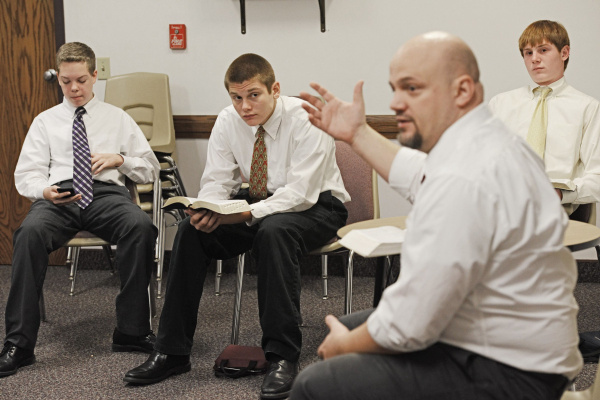How to Tell Amazing Stories in Sunday School
From Alma to Christ, the great Gospel teachers taught in stories and parables. Our scriptures are filled with stories from the ancient Saints. Stories clearly play an important part in learning of the Gospel, but how do we use this power when learning for ourselves and teaching to others? Below are some tips and tricks on teaching through stories.
How to Teach with Stories
[quote_box_center]”… I’d argue that one of the most innovative ways to teach may be to slow down, and tell a story. Figuring out what story to tell, and how it connects, is the job of any great teacher. If we want our students to change the world, they’ll need some inspiration from the stories of those that have already changed the world,” (A.J. Juliani).[/quote_box_center]
There are many ways to reach students. Some students are visual learners, some are auditory, etc., so of course not every teaching technique will apply to every student. That being said, since stories are such a vital part of the human psyche, it’s a good bet that almost all of your students will learn through storytelling.
Here are some ways in which an enterprising teacher might use stories in their gospel lessons to provide insight.
1. Use Your Own Stories

This hopefully isn’t a challenge! Simply living life will give you material to pull from, especially if you keep the Spirit with you and are mindful of your lesson material. You will more easily pick out pertinent life experiences if you do.
Think back to your high school classes. What do you remember? The conversations you had with your friends? The information you learned? Well, maybe, but most likely you remember stories.
The stories we tell each other are less grandiose than the ones we see on screens or in books and might not immediately come to mind as stories that have shaped you. However, it’s from the small day-to-day stories of gossip, trying times, and uplifting moments that we often learn the most about ourselves, each other, and the gospel.
2. Know the Stories You Are Teaching

The scriptures consist of stories wrapped in stories. Keeping track of all them can be tricky, but if you have a basic understanding of the content in the Bible and of the way the prophets taught, you can keep the stories straight in your mind.
In the Bible there are many analogies and parables—most notably the parables of Christ. As defined by Wikipedia, a parable is “a succinct, didactic story, in prose or verse, which illustrates one or more instructive lessons or principles. A parable is a type of analogy.”
There are 23 unique parables in the four Gospels, and an additional number of repeated parables. Christ’s parables include the ten virgins, the talents, the tares, the Good Samaritan, etc.
Christ says in Matthew 13: 10-11, “And the disciples came, and said unto him, Why speakest thou unto them in parables? He answered and said unto them, Because it is given unto you to know the mysteries of the kingdom of heaven, but to them it is not given.”
He was inspired to use the understandable and concrete examples from his day to explain the difficult and ephemeral concepts of the gospel to his students. You too can follow Christ’s example in teaching difficult subjects to your students.
To know the material you are pulling from: Study the scriptures on a daily basis and review the lesson material at least a week before your lesson to have time to prepare appropriate stories. Read here for more teaching ideas.
3. Keep the Story Simple

Our modern apostles are great at telling succinct and powerful stories. Ever since the restoration of the gospel the apostles have used these stories to appeal us and teach us concepts like honesty, faith, and charity.
In this article by President Harold B. Lee, he lists stories that he learned from. Take a quick read through of the article. How did it affect you? Did it appeal to you in the same way that Christ’s parables did? While the two types of stories are separated by time and distance, they both carry profound messages to our hearts.
Our own President Monson is well-known for using stories in his addresses, particularly stories from his childhood or time serving the people in his ward.
In one story, he recounts how he counseled a young couple who were struggling to keep the law of chastity before their marriage. Through their humility and President Monson’s counsel, the couple kept the law of chastity and were married later in the temple (Read more stories from President Monson on LDS Living).
We understand the apostles’ modern stories partly because they are so relatable and simple to understand. They understand the power of a sweet and simple message.
To keep the story simple practice telling your stories before class. Practice on your spouse, niece, son, neighbor, anyone who will listen. As you practice your stories, they will become more potent and slick with time, perfecting them for your lesson.
4. Invite Interaction from Your Audience

Stories, more than any other verbal form of information transference, appeal to our senses. Studies show that the brain uses narrative structure to make sense of all the random events that happen in our day. Through this narrative structure we, as children, impose order on our world to provide coherence. Especially when we are young, this process is key to learning.
Interestingly, the importance of narrative doesn’t decrease as we get older. In fact, we continue to learn through the simple everyday stories we tell one another.
When a person is telling a story, say about getting stuck in line at the grocery store, the teller’s and listener’s brains “sync up,” and the listener’s brain mimics the electromagnetic pulses in the teller’s brain. In other words, the listener’s brain lights up in the same areas as the teller’s brain when the teller describes placing items in her cart or rolling her eyes in line.
By “living” the teller’s experience, the listener not only remembers the message of the story, he feels like he has been there with the teller. This skill of the mind is as valuable to us as we are learning ways to make our lives more comfortable and less frustrating.
This tendency of the brain to “live” the experience can be used especially to keep listeners interested in the lesson—they want to hear how the story ends! Pause at certain relevant points in the story to ask questions and talk about discussion points. That way the listeners will stay engaged in the discussion and get more out of the lesson.
To invite interaction plan out pauses in your story specifically for comments and discussion. Come up with two or three questions you can ask the students during the discussion periods. Plan for what to do when the students stray off of topic, and make sure to always validate the students’ comments and questions.
5. Use Physical Aids

People love looking at things. As visual creatures, we use our eyes to navigate the world and protect us from harm. Since we place so much importance on visual cues, then, bringing in physical aids to our discussion can help to ground the story for our listeners. Whether it be a picture of Christ when talking about His parables or a fisherman’s lure when discussing fishers of men, people like seeing things.
To use physical aids plan out what stories you will use and place yourself in the role of the listener. What physical aid would best illustrate the stories and concepts you are describing? Ask others around you what would help them when listening to the story.
6. Invite the Spirit

Nothing ensures a loving discussion like the constant presence of the Spirit. Make sure to consult with the Spirit before sharing a personal story that might not fit with the lesson. The story might range from too sacred to too irreverent, so keep yourself open to inspiration.
To invite the Spirit be living righteously. Read the scriptures, pray, go to the temple if you can, really just live in a manner conducive to having the Spirit with you. The day of your lesson, pray to have the Spirit with you and ask for
6. Use the Mechanics of Great Storytelling
In Utah, there is a festival solely dedicated to Storytelling. The storytellers who speak at the festival are masters of their craft. They’ve spent a lifetime gathering stories, practicing them over and over, and presenting them to lively audiences. Here are some of the key points on how to tell stories.
Make a promise at the beginning of your story. Even something like, “Once upon a time” promises a tale of adventure to your listener.
Trust your listeners. You are speaking to intelligent people, so let them work a little in in your narrative. Craft your story such that will lead the audience to make assumptions and guess where you are taking the story.
Change is necessary. Change is an integral part of storytelling. If the story doesn’t have change in it, it becomes static and boring.
Play with your voice. Speak in different voices for different characters, pause during critical moments, and vary your voice level to heighten the drama. People like stories that will engage them and keep them on the edge of their seat.
Check out a great infographic on storytelling and watch a quick Youtube about it.
Check out this article for more ideas on how to use stories in lessons.
How to Learn with Stories

[quote_box_center]”Over the last 25 years, a small canon of research on family storytelling shows that when parents share more family stories with their children—especially when they tell those stories in a detailed and responsive way—their children benefit in a host of ways,” (Elaine Reese).[/quote_box_center]
Often, we are not the teacher telling stories but the listener hearing them. We have the responsibility of listening to the story, appreciating it, and, perhaps, trying to learn something from it. Here are some techniques on how to get the most out of any story you hear.
1. Listen
Probably the most important thing to remember when learning from stories (or learning in general) is to listen. Listen to the story and the comments after to get the most out of the conversation between the teacher and you. Read this article from the Huffington Post for tips on how to be a better listener, which include having an open mind and asking engaged questions.
2. Remember the Personal Nature of Stories
Especially if the story is from the teller’s life, and even if it is a retelling from another person’s, remember that stories are inherently personal. You won’t always be able to relate to them, but you can always learn something from another’s experience. Even if it is simply that you didn’t know as much about the world as you thought you did.
3. Don’t Get Caught up on the Language
This is a difficult point to sometimes put into practice, but don’t get caught up in the specific words the teller uses if you disagree with the story. Try to hear the intent of what the person is saying behind the language. Getting caught up in semantics is usually not helpful and distracts from the overall message of the story.
4. Let Yourself Be Whisked Away
The purpose of stories is to connect with people and learn something through their experiences. Let yourself live and relate to their story. You’ll understand the overall lesson more (in a gospel setting) and enjoy the story!
5. Engage in Discussion
 Especially in a gospel setting, be thinking of ways the story teller’s experience relates to you and similar experiences you’ve had. Comment on the story, ask questions, and drive the discussion forward. It’ll show the teacher that you are getting
Especially in a gospel setting, be thinking of ways the story teller’s experience relates to you and similar experiences you’ve had. Comment on the story, ask questions, and drive the discussion forward. It’ll show the teacher that you are getting
something out of the lesson and it will encourage others to participate as well.
Christ, the Master Teacher, taught his disciples with stories and parables; should we not also try the same?
Have any good teaching tips? Do you know the sure-fire way to tell stories to your class? Share below!


